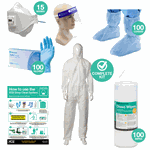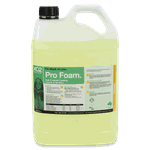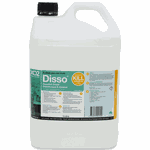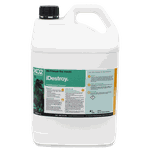This article is dedicated to all of our family, friends and fellow Aussies who have been affected by floods. Our thoughts and prayers are with you, as are our resources.
The most common questions we are asked about during and after floods are…
“How do I clean up the severe soil build-up”.
“How do I decontaminate spaces and surfaces so it’s safe again”
“How do I remove the odours and mould”
"Does vinegar and clove essential oil work for mould and flood clean ups" and…
“How do I stop the mould and smells from coming back”.
For the health, safety and hygiene of ourselves and others, we need to get serious about how we clean up after a flood. This is not like doing your normal house cleaning duties. This is about dealing with a disaster.
In a hurry?
If you just want to see the chemicals you need for flood clean-up and decontamination skip to Steps 3 and 4 below.
And if you just want to know if vinegar and clove essential is suitable for mould removal and flood clean up just scroll to the end of this article.
Let’s get into the “how to”....
Step 1. Prepare and stay safe
To ensure the site is safe to enter. Consider these 3 things…
a. Biological Hazards
Flood waters contain dangerous substances and the effects of floods bring deadly hazards along with them. Substances include things like sewerage, dead animal traces, virus’, bacteria and all sorts of other nasties. Contact with these bad boys can lead to short and long-term health problems.
IMPORTANT: Decontamination (Step 4 below) after a flood is critical for your health and safety.
b. Structural & Electrical Hazards
Ensure the site is safe to enter. This includes electrical, structural and land integrity.
i. Only use electrical devices fitted with an RCD that has been tested and is working.
ii. Check electrical cords are in good condition, have a current test & tag and are undamaged.
iii. WARNING: Do not use any electrical equipment unless a licensed electrician has checked and approved the electrics in the area as safe to use.
c. Wear PPE (Personal Protective Equipment)
Always wear protective clothing (PPE). Due to the contamination in some floodwaters and water damage... hand (nitrile gloves), head (hard hat), eye (goggles), breathing (respirator), feet (sealed footwear) and protective clothing (coveralls) must be worn to avoid contact.
If it’s not safe, forget it! Do not proceed until it is safe to do so.
Step 2. If possible, begin the drying process. If not, go to Step 3.
a. If required, remove wet carpets, curtains, soft furnishing and porous surfaces. You may need to ask your insurance company for instructions or they will organise this for you.
b. Squeegee or wet vac/extract as much water and moisture as possible
c. Get some dehumidifiers. Your insurance company may organise this for you. These machines suck the moisture out of the air and surfaces. They are awesome but in very high demand during floods.
d. Turn your air conditioner system on. It’s not as good but it does a similar job to a dehumidifier. Or ventilate the area by opening windows if it's dry outside.
c. Air movers and fans may also be helpful.
Step 3. Clean
a. Remove the big stuff (eg. furniture)
Once you have removed all the big stuff and given the space a pre-wash (if possible) it’s time to clean.
b. Wash down and clean with ProFoam (Cleaner and sanitiser)
In flood applications, we recommend our high-performance foaming cleaner and sanitiser called Pro Foam. A great way to get this foaming cleaner onto walls, ceilings and everywhere else is via the Carrot Top foaming sprayer that dilutes the chemicals for you. Alternatively, you can brush it onto the surfaces. Leave the chemical on the surface for 5-10 minutes and then give it a good scrub before you rinse it off. Squeegee and/or vacuum the area to remove excess liquid. Repeat this process if necessary.
Step 4. Treat & Decontaminate (Also removes the source of odours)
a. Decontaminate with Disso® (Hospital grade antimicrobial)
Disso® is Australia’s leading after-flood decontamination and restoration treatment.
It's TGA (Australia's Therapeutic Goods Administration) listed and is proven to kill...
• Staphylococcus aureus (Golden Staph)
• Pseudomonas aeruginosa
• Enterococcus hirae
• Escherichia coli (E-Coli)
• Salmonella choleraesuis
• Trichophyton mentagrophytes
• Coronavirus (SARS-CoV-2, COVID-19)
• Influenza virus type A
• Herpes Simplex virus
• Poliovirus (Polio)
• Vaccinia virus (Smallpox, Cowpox)
and more.
Do not dilute Disso®, it is ready to use! Apply liberally to all washable surfaces via an Electrostatic Handheld Sprayer (or a backpack one), a pump-up sprayer (like the ones at Bunnings), a spray bottle or another suitable method. Leave the product on the surface to dry, do not rinse.
b. Still got mould? Use iDestroy (Spray or brush on and leave)
Floods are the perfect conditions for mould. If you are still having issues with mould after the clean-up which is likely, treat the affected surfaces with iDestroy. iDestroy is not only amazing at removing mould it also helps stop the mould from returning.
Step 5. If you need more help, please contact us.
We are here to help you clean better, so please get in touch if you need advice in any way.
Our phone number is
FAQs (Frequently asked questions)
1. What chemical-free options would XO2 recommend for flood clean-up, decontamination and mould removal?
We all want to avoid using hazardous and dangerous chemicals but be careful of chemical-free product claims. Remember water is a chemical (H2O). So when you see chemical-free claims keep in mind it is more marketing terminology than truth. In most cases what chemical-free means is the chemical is non-hazardous which is not a very high standard.
What's also important is for us all to consider the health hazards of an ineffective mould treatment. It is absolutely critical you get your mould removal system right for the health and safety of you and those who enter the places and spaces you are responsible for. Balancing your product choice with the level of proven effectiveness and any safety hazards is wise when choosing an approach.
2. Is vinegar suitable for flood cleanup?
Some professionals do use vinegar for flood clean-ups however at this point in time we do not recommend it. Vinegar has not been sufficiently substantiated as being effective for use on heavily contaminated surfaces. It is not recognised by the TGA for this type of application. In humid conditions, the water component of a vinegar solution could even further worsen a moisture problem. Keep in mind that vinegar does not function as a surfactant which means it will not help with the physical removal of fungal material from surfaces.
3. Are essential oils like clove, thyme and cinnamon effective for flood clean-ups and mould treatment?
Some essential oils have been shown to have antifungal properties. Essential oils like clove, thyme and cinnamon may have an initial antifungal effect. The volatile component of the essential oil evaporates in a short period of time, and what is left behind on the surface is an essential oil residue. This oil residue can hold nutrients that help mould grow. When using essential oils you should also consider the safety hazards including skin contact hazards.
4. What scientific papers or TGA-recognised testing is available that proves the effectiveness of vinegar or clove essential oil for flood cleanup and mould control?
If reputable scientific evidence was currently available that demonstrates vinegar and clove essential oil as being effective for mould removal, flood clean up and decontamination the labelling would say so. Currently, we have not seen any evidence that would allow these products to be called 'mould killers' under Australian regulations. If you have any laboratory testing that says otherwise please forward it to us as we would love to see it.
5. Will mould come back after it has been treated effectively?
The mould spores are the reproductive particle of moulds. They are always present in the air in both indoor and outdoor environments. They can't be 100% eliminated but they can be reduced. The most important step in preventing mould from returning is to treat the moisture problem. If there is moisture or humidity mould will return, even on clean surfaces.

David Blamire, CEO at XO2
David is one of Australia's leading cleaning industry innovators. He's spent his entire working life solving cleaning challenges others thought were impossible. He's best known for his product creation and development skills along with a deep knowledge of business operations and all things ERP. In his spare time, David's a keen fisherman and adventurer. And he doesn't mind if you call him Davo.
Get in touch with David at www.xo2.com.au. He works from XO2's national headquarters and manufacturing centre in Queensland, Australia.
Related articles:
- Carpet Drying And Clean Up With The Express Method
- 3 Crucial Clean Up Steps That Need To Be Done After A Flood Disaster
- How To Kill Mould & Stop It Coming Back (Like A Professional)
- 10 Rules You Can't Break When Using An Air Mover & Carpet Blower Or Someone Might Get Hurt



